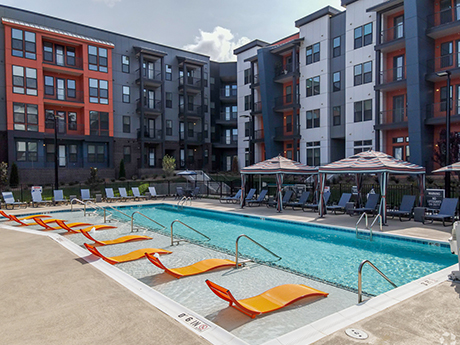As Charlotte continues to expand its economy and population, its multifamily market is reporting unprecedented levels of activity. The market has experienced a tremendous rebound from the artificial pandemic performance in terms of investor demand, in-migration and rent growth.
The market recorded double-digit rent growth in 2021, extremely tight vacancies across submarkets, record lease-up velocity and a modest supply of new deliveries. All these signs clearly point to a landlord’s market, and investors have taken notice.
This year looks to be another solid one for Charlotte’s multifamily investment market, coming off a record-setting 2021 with nearly $6.4 billion in transactions (compared to $3.5 billion in 2020 and $3.7 billion in 2019).
So far in 2022, pricing remains strong and sales are ahead of the pace set at the start of last year ($1 billion in first-quarter 2022 vs. $566 million in first-quarter 2021).
Companies and residents are flocking to Charlotte, which is increasingly recognized as a high-growth market. It is business-friendly, offers a great lifestyle and is a talent magnet. Lowes, USAA and Centene are examples of companies expanding their footprints and hiring thousands of employees, all who need a place to live.
Moreover, these are high-paying jobs ($100,000-plus), targeting a younger tech-enabled workforce, which bodes well for multifamily market fundamentals.
There is already significant pent-up demand from renters, and these companies’ expansions have not opened yet. Additionally, soaring housing prices have priced out many would-be homebuyers.
Transaction size increases
Investors are stepping up activity in Charlotte. Ten $100 million-plus transactions closed in 2021, and five such deals have already closed by April 2022.
More investment groups are viewing Charlotte as an institutional market, including pension funds, insurance companies, private equity and high-net worth-individuals. The market liquidity is at an all-time high.
Despite rising interest rates, deals are pushing through. Northmarq has had $1.7 billion of multifamily assets on the market throughout the Carolinas year-to-date. Many participants would have assumed the interest rate increase would have slowed activity; however, that was not necessarily the case. For prime assets in the best locations, Charlotte’s market fundamentals remain incredibly strong.
Northmarq was recently awarded an asset that had 15 offers, three rounds of bidding and was as competitive as before the run-up in interest rates. While interest rates are having a slight impact on pricing, the depth of the market of bidders remains robust.
For borrowers, the cost of capital has increased, but that is offset by accelerating rent growth. From a capital perspective, investors remain attracted to Charlotte and need to allocate their commercial real estate percentage in high-growth markets like the Queen City, which forecasts strong employment trends and accelerating rent growth for multifamily assets.
Flight to quality
In a sign of flight to quality among investors, nearly every asset was trading at roughly the same cap rate, whether it was value-add or a newly developed, core property.
It appears a return to normalization has occurred where value-add is now showing a risk premium relative to newly built core assets. The interest rates have had the least impact at the top of the quality spectrum, and the impact is greater among the deeper, value-add assets.
For core assets, cap rates are in the mid- to high 3 percent range, which is above where it was 90 days ago by 25 or 30 basis points, which remains an attractive price point. Because of the rent growth and asset appreciation occurring over the last several years, investors are sitting on huge, embedded gains.
There is so much profit remaining in these assets that it will continue to drive the investment sales market. For example, Northmarq will soon launch the marketing of Novel LoSo Station, a trophy asset in Lower South End, a popular submarket for young renters.
Northmarq expects very competitive bidding with institutional, all-cash groups that are less sensitive to rising interest rates. Accordingly, Northmarq remains bullish on investment demand in this flight-to-quality environment.
Who is lending?
Lenders are also focusing on flight to quality. We are still seeing immense demand for multifamily from our lenders, which have an abundance of capital to allocate. That means multiple options for borrowers as lenders are still competing to win business.
If 2021 was the year of the bridge lender, then 2022 is the year of the bank and balance sheet lender. Banks, life companies and the government-sponsored enterprises (Freddie Mac and Fannie Mae) are seeking multifamily investments and, although the agencies have not been nearly as competitive in the last a year and a half, we are starting to see them show up again and expect them to regain some market share.
While there remains uncertainty and the potential for interest rate increases throughout 2022, Charlotte is well-positioned as an attractive multifamily market for both investors and lenders.
This article was originally published in the June 2022 issue of Southeast Real Estate Business.



